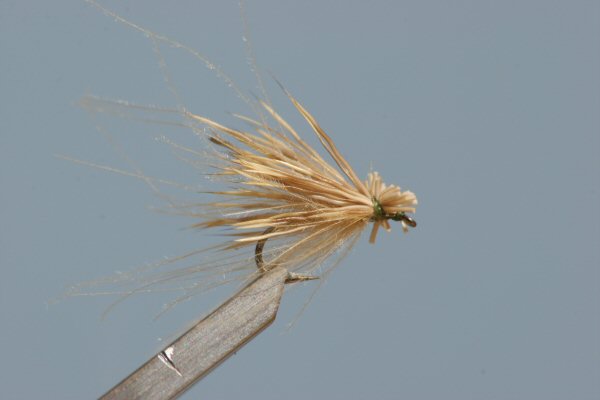Archives
now browsing by author
Posted by: admin | on October 14, 2012
CDC & Elk
CDC & Elk |
|
This version of the Elk Hair Caddis was developed by Hans Weilenmann. |
|
|
|
|
Materials |
|
| Hook | Dry Fly Hook #12 to #20 |
| Thread | Tan 6/0 |
| Body | CDC |
| Wing | Elk or Deer Hair (Klipspringer works well) |
Tying Instructions |
|
| 1) Tie in a spade shaped CDC feather by its tips above the barb of the hook.
2) Wrap the CDC forward around the hook shank forming the body. 3) As the CDC gets closer to the hook eye more and moor loose strands of feather appear. Stroke these back away from the hook eye and tie off just behind the eye. Leave enough room for the wing and head. 4) Stack a small clump of Elk hair and tie in the wing with a few tight turns. The wing should not extend beyond the bend of the hook. 5) Form a neat head under the Elk hair, whip finish and apply a drop of head cement. |
|
Hans Weilenmann Fishing Instruction Quote |
|
| The CDC & Elk is a very versatile pattern. While originally designed to be a dry caddis imitation, it has proven to be much more than just a ‘better’ caddis pattern! It is by far my most productive dry to use during mayfly hatches, as well as my staple search pattern during hatchless periods. Fish it as an emerger in the film. Or as a straight wet. It has proven to cover the full spectrum of dry, ‘damp’and wet. As an extremely effective 2-materials 2-minutes-to-tie this is one hard to pass up pattern. I suggest you try it! | |
Posted in Fly Tying, Fresh Water Fly, Trout | No Comments »
Posted by: admin | on October 14, 2012
Funnel Dun
Funnel Dun |
|
The Funnel Dun is a fly which Jack Blackman first introduced to us when we were still Natal Fly Dressers Society, Durban Branch – a long time ago. |
|
|
|
|
Materials |
|
| Hook | An up-eyed dry fly hook is preferred but a down-eyed dry fly hook works as well, sizes 12 to 18 |
| Thread | 6/0 – in colour to suit your chosen scheme |
| Thorax | Any dubbing material, usually darker than the abdomen. Hares Ear blend works well. |
| Hackle | Long barbuled cock hackle – colour to suit (I prefer a length of 1,5 times the hook shank) |
| Body | Soft fur dubbing of colour to suit |
| Tail | Same as for hackle – again 1,5 times the length of the shank. |
Tying Instructions |
|
| 1 : Place hook in vice, secure the thread and take it to a position just past the eye. Form a dubbing noodle with your selected material and form a neat thorax just behind the eye. The thorax should have a diameter of about a fifth to a quarter of the shank length.
2: Strip the flue off the hackle and tie the stem in at the back of the thorax, with shiny side out. Trim off the excess stem and wind the hackle backward (towards the hook bend) two to three times around the shank and tie off. Shape the hackles so that they form a funnel shape over the thorax. This is done by holding the hackle tips in the fingers of the one hand and winding the thread loosely up the barbules with the other hand and then back again. This should keep the hackle in the funnel shape. If the thread is wrapped too tightly the barbules will splay in all directions. 3: Wind the thread to a position above the barb and tie in three or four barbules for the tail. By holding the barbules down with your left hand, wind the thread to about a quarter of the way around the bend. Take the thread back to behind the hackle.Step 4: Dub body material onto the thread and form a tapered body by winding back to the tail. Tie off at the tail with a whip finish. The tie off can also be done with a yellow colour thread to imitate an egg laying insect. Happy hunting! |
|
Posted in Fly Tying, Fresh Water Fly, Trout | No Comments »


 D5 Creation
D5 Creation